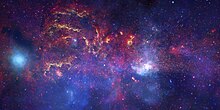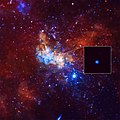From Wikipedia, the free encyclopedia
This pan video gives a closer look at a huge image of the central parts of the Milky Way made by combining thousands of images from ESO's VISTA telescope on Paranal in Chile and compares it with the view in visible light. Because VISTA has a camera sensitive to infrared light it can see through much of the dust blocking the view in visible light, although many more opaque dust filaments still show up well in this picture.
Animation of a barred galaxy like the Milky Way showing the presence of an X-shaped bulge. The X-shape extends to about one half of the bar radius. It is directly visible when the bar is seen from the side, but when the viewer is close to the long axis of the bar it cannot be seen directly and its presence can only be inferred from the distribution of brightnesses of stars along a given direction.
The Galactic Center (or Galactic Centre)[1] is the rotational center of the Milky Way. It is located about 8.33±0.35 kpc (~27±1 kly) from Earth[2][3][4][5][6] in the direction of the constellations Sagittarius, Ophiuchus, and Scorpius where the Milky Way appears brightest. There is strong evidence consistent with the existence of a supermassive black hole at the Galactic Center of the Milky Way.
Proof of existence and location
Because of interstellar dust along the line of sight, the Galactic Center cannot be studied at visible, ultraviolet or soft X-ray wavelengths. The available information about the Galactic Center comes from observations at gamma ray, hard X-ray, infrared, sub-millimetre and radio wavelengths.Coordinates of the Galactic Center were first found by Harlow Shapley in his 1918 study of the distribution of the globular clusters. In the equatorial coordinate system they are: RA 17h45m40.04s, Dec −29° 00' 28.1" (J2000 epoch).
Distance to the Galactic Center
The exact distance between the Solar System and the Galactic Center is not certain. The latest estimates from geometric-based methods and standard candles yield distances to the Galactic Center between 7.6 and 8.7 kpc (25–28 kly).[7][8][9][10] An accurate determination of the distance to the Galactic Center as established from variable stars (e.g. RR Lyrae variables) or standard candles (e.g. red-clump stars) is hindered by countless effects, which include: an ambiguous reddening law; a bias for smaller values of the distance to the Galactic Center because of a preferential sampling of stars toward the near side of the Galactic bulge owing to interstellar extinction; and an uncertainty in characterizing how a mean distance to a group of variable stars found in the direction of the Galactic bulge relates to the distance to the Galactic Center.[10][11]The nature of the Milky Way's bar which extends across the Galactic Center is also actively debated, with estimates for its half-length and orientation spanning between 1–5 kpc (short or a long bar) and 10–50°.[9][10][12] Certain authors advocate that the Milky Way features two distinct bars, one nestled within the other.[13] The bar is delineated by red-clump stars (see also red giant), however, RR Lyr variables do not trace a prominent Galactic bar.[10][14][15] The bar may be surrounded by a ring called the "5-kpc ring" that contains a large fraction of the molecular hydrogen present in the Milky Way, as well as most of the Milky Way's star formation activity. Viewed from the Andromeda Galaxy, it would be the brightest feature of the Milky Way.[16]
Supermassive black hole
A study in 2008 which linked radio telescopes in Hawaii, Arizona and California (Very Long Baseline Interferometry) measured the diameter of Sagittarius A* to be 44 million kilometers (0.3 AU).[17][18] For comparison, the radius of Earth's orbit around the Sun is about 150 million kilometers (1.0 AU), whereas the distance of Mercury from the Sun at closest approach (perihelion) is 46 million kilometers (0.3 AU). Thus the diameter of the radio source is slightly less than the distance from Mercury to the Sun.
Scientists at the Max Planck Institute for Extraterrestrial Physics in Germany using Chilean telescopes have confirmed the existence of a supermassive black hole at the Galactic Center, on the order of 4.31 million solar masses.[19]
On 5 January 2015, NASA reported observing an X-ray flare 400 times brighter than usual, a record-breaker, from Sagittarius A*. The unusual event may have been caused by the breaking apart of an asteroid falling into the black hole or by the entanglement of magnetic field lines within gas flowing into Sagittarius A*, according to astronomers.[20]
Stellar population
The central parsec around Sagittarius A* contains thousands of stars. Although most of them are old red main-sequence stars, the Galactic Center is also rich in massive stars. More than 100 OB and Wolf–Rayet stars have been identified there so far.[21] They seem to have all been formed in a single star formation event a few million years ago. The existence of these relatively young stars was a surprise to experts, who expected the tidal forces from the central black hole to prevent their formation. This paradox of youth is even stronger for stars that are on very tight orbits around Sagittarius A*, such as S2 and S0-102. The scenarios invoked to explain this formation involve either star formation in a massive star cluster offset from the Galactic Center that would have migrated to its current location once formed, or star formation within a massive, compact gas accretion disk around the central black-hole. Most of these 100 young, massive stars seem to be concentrated within one or two disks, rather than randomly distributed within the central parsec.[22][23] This observation however does not allow definite conclusions to be drawn at this point.
Star formation does not seem to be occurring currently at the Galactic Center, although the Circumnuclear Disk of molecular gas that orbits the Galactic Center at two parsecs seems a fairly favorable site for star formation. Work presented in 2002 by Antony Stark and Chris Martin mapping the gas density in a 400-light-year region around the Galactic Center has revealed an accumulating ring with a mass several million times that of the Sun and near the critical density for star formation. They predict that in approximately 200 million years there will be an episode of starburst in the Galactic Center, with many stars forming rapidly and undergoing supernovae at a hundred times the current rate. This starburst may also be accompanied by the formation of galactic jets as matter falls into the central black hole. It is thought that the Milky Way undergoes a starburst of this sort every 500 million years.
In addition to the paradox of youth, there is also a "conundrum of old age" associated with the distribution of the old stars at the Galactic Center. Theoretical models had predicted that the old stars—which far outnumber young stars—should have a steeply-rising density near the black hole, a so-called Bahcall–Wolf cusp. Instead, it was discovered in 2009 that the density of the old stars peaks at a distance of roughly 0.5 parsec from Sgr A*, then falls inward: instead of a dense cluster, there is a "hole", or core, around the black hole.[24] Several suggestions have been put forward to explain this puzzling observation, but none is completely satisfactory.[25][26] For instance, although the black hole would eat stars near it, creating a region of low density, this region would be much smaller than a parsec. Because the observed stars are a fraction of the total number, it is theoretically possible that the overall stellar distribution is different than what is observed, although no plausible models of this sort have yet been proposed.
Gallery
-
The center of the Milky Way. Image taken by ISAAC, the VLT's near- and mid-infrared spectrometer and camera.
-
Infrared image from Spitzer Space Telescope.
-
A view of the night sky near Sagittarius, enhanced to show better contrast and detail in the dust lanes. The principal stars in Sagittarius are indicated in red.
-
The central parts of the Milky Way, as observed in the near-infrared with the NACO instrument on ESO's Very Large Telescope.
-
Detection of an unusually bright X-Ray flare from Sagittarius A*, a supermassive black hole in the center of the Milky Way galaxy.[20]









